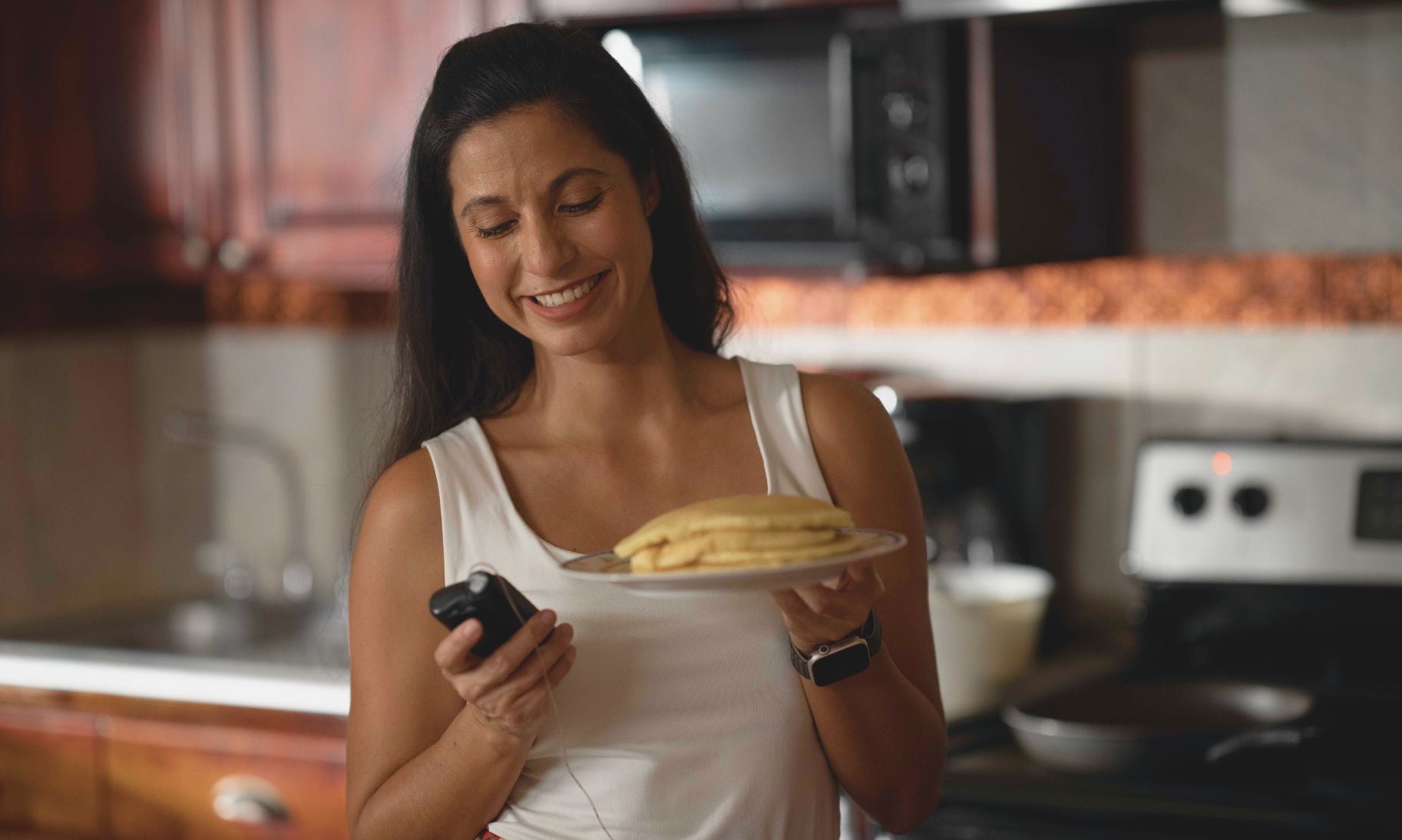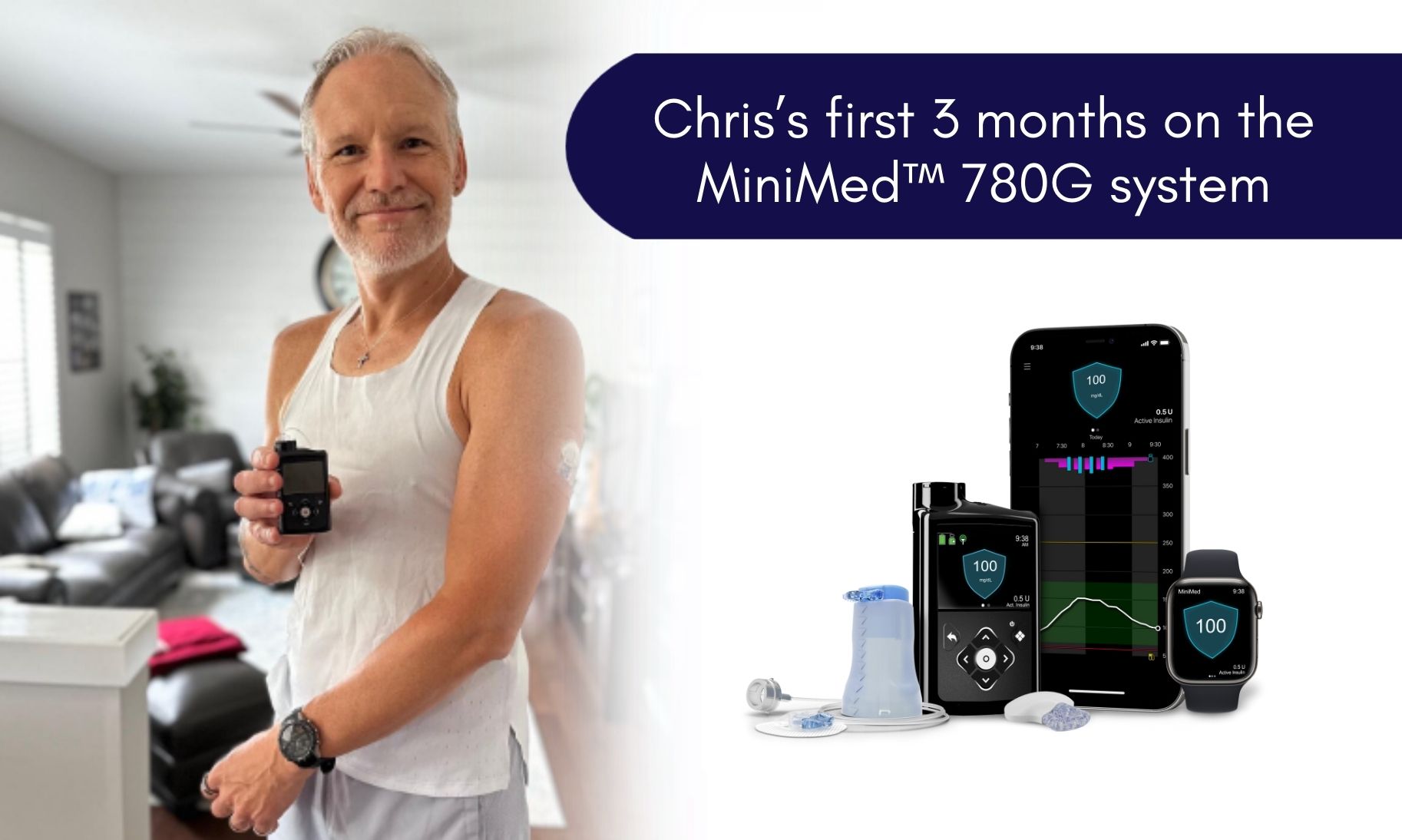MiniMed™ 780G system review: Jaime’s first 30 days

Three days I will never forget
I’m Jaime, a Medtronic Employee who’s been living with type 1 diabetes since I was three years old and wearing an insulin pump for the last 20+ years.
Over the years, it's very easy to get lost in the countless blood sugar checks, numerous sensor changes, and daily management of a disease like type 1 diabetes. It's a blur of juice boxes, juggling insurance claims, doctors’ appointments, pharmacy runs, tears, waking up in the middle of the night covered in sweat, laughter, mental math, pump alerts, triumph, calloused fingers, workouts, strength, and glucose tablets.
But in the last 20 years, three days stand out.
Three days I will never forget. Three days when I truly felt hopeful about my diabetes. And three days where I had a sense of relief that I now have something in my corner of the ring as I put on the gloves and fight this disease.
- My very first day on my MiniMed™ Paradigm 512.
- My very first day on the MiniMed™ 670G with Auto Mode™.
- The day I did a remote software upgrade to the MiniMed™ 780G system.
So, I’m very excited to share my experiences with the MiniMed™ 780G system — the highs and the lows (see what I did there?)!
What I love about the MiniMed™ 780G system
The theme you will notice throughout my MiniMed™ 780G review is that I’m achieving the best control of my life with the least amount of brain power, effort, and exertion.
The software update was super easy to do.
I feel like if you can do an iOS update on your phone, you can do a software update for your pump. And that’s coming from someone who wouldn’t exactly classify herself as tech-savvy.
After I completed my online training, the software update process was really easy to follow. Medtronic even sent out a nice software update guide brochure to follow which came in so helpful (I’m a visual person). It took me about 2 hours to do and then I had my MiniMed™ 780G system up and running.
The results are amazing!
I typically achieve a good Time in Range (TIR), but I can only do that when I’m firing on all cylinders. This means accurately counting carbs, pre-bolusing, hitting my activity levels, doing countless fingersticks, and eating a fairly low-carb diet.
With my new system, I’m reading an increase in TIR! The best part is that it’s EASY for me to do it on a daily basis. I can consistently do it, and depending on the day, I might be knocking it out of the park. Then other days where life gets in the way, and my diabetes management takes a temporary backseat, I can still come in healthy for the day.
I got my sleep back.
Nighttime used to be a struggle for me. I would worry about going low or would struggle with extreme fatigue due to being woken up by pump alarms. I would also proactively eat a snack right before bed to avoid lows and then struggle to stay in range while I slept. And then in the mornings I would struggle with dawn phenomenon—skyrocketing to the mid-200s. Utterly exhausting.
My night times are much more peaceful now. SmartGuard™ technology has my back—dosing quietly in the background so I can get some sleep. I can confidently turn the reigns over at night and am so happy to wake up in the mornings in range! It’s an awesome feeling to look at my overnight graph now and see a fairly straight line—I used to be so jealous of people who could do that! The frequency of alerts/alarms has also dropped dramatically—I’m sleeping through the night and waking up rested and refreshed.
Another bonus: even my husband mentioned how much better he is sleeping now that I’m in range at night! #GetItBack
No calibrations when using the Guardian™ 4 sensor with SmartGuard™ technology.
My fingertips have never felt so good. Excluding the one fingerstick I have to do each week when I change my sensor to get into SmartGuard™ mode, I do not have to check my blood glucose nearly as often as I used to.**
Overall, I’ve found the Guardian™ 4 sensor to be accurate and I feel confident trusting it to do its thing. I will do an occasional finger check before I work out or before bed just to confirm, but that’s honestly more out of habit.
I feel stable.
I’m the type of person with diabetes who has a lot of blood sugar fluctuations based on stress, activity levels, and hormones. I would constantly be chasing a high spike right before I presented in a big meeting at work or chasing a low after a gym workout. The constant ups and downs were exhausting — mentally and physically.
On the MiniMed™ 780G system, I’m really only interacting with the pump when I’m setting a temp target for my workouts or I have to step in to fix an unexpected low. The pump is quietly giving me little tiny corrections in the background, bringing me gently back into range. It’s adjusting to cover me when I occasionally miscount carbs. It’s adapting for my weird slight spikes I get when I lift weights. I’m seeing more straight lines on my graph than I have in my life.
The mental load of diabetes has been lifted.
It’s definitely not gone—but it’s drastically lifted. The amount of time, energy, worry, stress, and attention I have to attribute to my diabetes is so minimal now. I used to say that diabetes is the first thing I think about when I wake up and the last thing I think about before I go to bed….and that’s not the case anymore. I’ve got the mental capacity, time, and energy to focus on other things—finally writing my book, running a 5k with my daughter, and planning our much-needed home renovation.
What I wish the MiniMed™ 780G system had
I’ll call these my “wish list” items. As I considered my MiniMed™ 780G system review, these are the things that I wish it had or had the capability to do.
Arm insertion is challenging if you are by yourself.
I need to have my husband on deck every Sunday to help me insert my sensor in my arm. I’m just not flexible enough to do it myself and lack the dexterity in my hands. That can cause a bit of a scheduling struggle when one of us goes out of town, so I’d love an easier insertion process.
Learning to manage exercise is a little tricky when you first start on the system.
Full transparency, I didn’t use the Temp Target feature consistently before for my workouts. I would normally just eat a snack to get me through the workout or pull back the amount of insulin I would take so I didn’t have too much insulin on board. With the MiniMed™ 780G system, I realized very quickly that I had to use the Temp Target, or I found myself going low during my workouts. It was a challenge some days to remember to do it in advance and to get the timing right depending on the type of workout I was going to do. I’m still in a trial-and-error phase right now, but I’m seeing a slightly better result this week than I did when I first started.
Deliver a bolus from the app.
I would absolutely love it if I could bolus from my phone app. Or clear alarms! This would amazing, especially when I’ve got my pump discreetly tucked away in my clothing. Anytime I do have to interact with my pump, I have to pull it out, so engaging with it via my MiniMed™ Mobile app would be much easier.
I’d love both the pump and the sensor to be smaller.
There was no design change with either component. They both can feel slightly bulky at times. I hope this MiniMed™ 780G system review helps you, and if you have any questions about my experience on the system, drop them below!
UPDATE — For more system reviews, check out:
- The MiniMed™ 780G system makes travel easier
- Medtronic customer, Marley, reviews the MiniMed™ 780G system
- Chris reviews new features of the MiniMed™ 780G system
References
** Fingersticks required in manual mode & to enter SmartGuard. If symptoms don’t match alerts & readings, use a fingerstick. Refer to user guide. Pivotal trial participants spend avg of > 93% in SmartGuard.
MiniMed™ 780G system with SmartGuard™ technology with Guardian™ 4 Sensor
The MiniMed™ 780G system is intended for continuous delivery of basal insulin at selectable rates, and the administration of insulin boluses at selectable amounts for the management of type 1 diabetes mellitus in persons seven years of age and older requiring insulin as well as for the continuous monitoring and trending of glucose levels in the fluid under the skin. The MiniMed™ 780G System includes SmartGuard™ technology, which can be programmed to automatically adjust insulin delivery based on the continuous glucose monitoring (CGM) sensor glucose values and can suspend delivery of insulin when the SG value falls below or is predicted to fall below predefined threshold values. The Medtronic MiniMed™ 780G System consists of the following devices: MiniMed™ 780G Insulin Pump, the Guardian™ 4 Transmitter, the Guardian™ 4 Sensor, One-press serter, the Accu-Chek™ Guide Link blood glucose meter, and the Accu-Chek™ Guide Test Strips. The system requires a prescription from a healthcare professional. The Guardian™ 4 Sensor is intended for use with the MiniMed™ 780G system and the Guardian 4 transmitter to monitor glucose levels for the management of diabetes. The sensor is intended for single use and requires a prescription. The Guardian™ (4) sensor is indicated for up to seven days of continuous use. The Guardian™ 4 sensor is not intended to be used directly to make therapy adjustments while the MiniMed™ 780G is operating in manual mode. All therapy adjustments in manual mode should be based on measurements obtained using a blood glucose meter and not on values provided by the Guardian™ 4 sensor. The Guardian™ 4 sensor has been studied and is approved for use in patients ages 7 years and older and in the arm insertion site only. Do not use the Guardian™ 4 sensor in the abdomen or other body sites including the buttocks, due to unknown or different performance that could result in hypoglycemia or hyperglycemia.
WARNING: Do not use the SmartGuard™ feature for people who require less than 8 units or more than 250 units of total daily insulin per day. A total daily dose of at least 8 units, but no more than 250 units, is required to operate in the SmartGuard™ feature. |
WARNING: Do not use the MiniMed™ 780G system until appropriate training has been received from a healthcare professional. Training is essential to ensure the safe use of the MiniMed™ 780G system.
WARNING: Do not use SG values to make treatment decisions, including delivering a bolus, while the pump is in Manual Mode. When the SmartGuard™ feature is active and you are no longer in Manual Mode, the pump uses an SG value, when available, to calculate a bolus amount. However, if your symptoms do not match the SG value, use a BG meter to confirm the SG value. Failure to confirm glucose levels when your symptoms do not match the SG value can result in the infusion of too much or too little insulin, which may cause hypoglycemia or hyperglycemia.
Pump therapy is not recommended for people whose vision or hearing does not allow for the recognition of pump signals, alerts, or alarms. The safety of the MiniMed™ 780G system has not been studied in pregnant women, persons with type 2 diabetes, or in persons using other anti-hyperglycemic therapies that do not include insulin. For complete details of the system, including product and important safety information such as indications, contraindications, warnings and precautions associated with system and its components, please consult https://www.medtronicdiabetes.com/important-safety-information#minimed-780g and the appropriate user guide at https://www.medtronicdiabetes.com/download-library.



